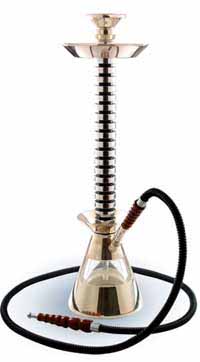ZybanThe growing fad of smoking tobacco through a waterpipe, sometimes known as a hookah, is rapidly turning into a worrisome epidemic, according to a Georgetown University researcher who says smokers who think this form of tobacco use is less toxic than cigarettes are wrong. Hold The Hookah: Researcher Warns
Against Trendy Tobacco Use"People who use these devices don't realize that they could be inhaling what is believed to be the equivalent of a pack of cigarettes in one typical 30-60 minute session with a waterpipe, because such a large quantity of pure, shredded tobacco is used," said Christopher Loffredo, Ph.D., Director of the Cancer Genetics and Epidemiology program at Georgetown University Medical Center.
His series of recently published studies documents the trend toward waterpipe tobacco smoking, showing how it has swept through the Middle East and is gaining popularity in the West, and demonstrates that the amount of cellular chromosomal damage produced inside the mouth is the same as that seen in cigarette smoking.
Yet waterpipe cafes or bars have been popping up all over the Eastern Mediterranean region over the past decade, Loffredo said. "In Egypt, we've seen boys starting to smoke the waterpipe at age 12, and young women, who are culturally discouraged from smoking cigarettes, are flocking to it," said Loffredo, who has been studying tobacco use in that country since 1997.
The trend has now hit European and American cities, especially college towns. "This is frightening because it is a gateway toward a lifetime use of tobacco, including cigarettes," he said.
Waterpipes were originally developed to smoke hashish and other substances, but were long ago adapted into a method to smoke tobacco. Use of the device is common throughout the Middle East, where it is goes by a number of different names - shisha in Egypt, hookah in Pakistan and India, and narghile in a number of countries from Turkey to Israel - but has historically been "a habit of older men, usually of low socioeconomic level, in rural areas and in older parts of cities," he said.
But the waterpipe has gained wider appeal since the early 1990s, accompanied by alterations in waterpipe size and design and also in tobacco content and flavorings, Loffredo said. "These changes are designed to attract more customers to the habit, and there has even been the introduction of tobacco home delivery service in some areas."
Several popular clubs in the Washington, DC, area, offer hookah pipes at a fee, using tobacco flavored by apples, molasses, or other ingredients. The pipe is often a social activity in that it is usually passed between participants, and is believed to be less toxic, Loffredo said.
"People think the water absorbs the toxins, and that is true to some extent if the toxins are water soluble, but tar isn't, and tar contains the carcinogens," he said. "We believe that, compared to the typical cigarette smoker, waterpipe smokers are exposed to larger total amounts of nicotine, carbon monoxide and certain other toxins."
"And because the tobacco is burning at a lower temperature, it is more tolerable to inhale deeply, and in fact you need more force to pull air through the high resistance of the water pathway," Loffredo said. "That means the tobacco smoke can be penetrating deeper in a person's respiratory tract than cigarette smoke does. The damage could be even worse than seen in cigarette smokers, but we haven't done studies long enough to quantify the true cancer risk."
Even so, the incidence of lung cancer is increasing rapidly in Egypt and other Middle Eastern countries, comparable to lung cancer rates in the U.S. after cigarette smoking became newly fashionable, Loffredo said.
His insights into "this significant and spreading epidemic of waterpipe smoking" were included in a recently released World Health Organization monograph authored by his research group. He also published a study in the July/August issue of the pathology journal Acta Cytologica about a new method his group developed to collect cheek cells from inside a participant's mouth, which can then be stained to gauge the chromosomal condition of these cells. They used this technique to study waterpipe smoking in a rural Egyptian village, and reported in a second study, published in 2003 in the Journal of the Egyptian Society of Parasitology, that the level of damage is comparable to what happens to cigarette smokers.
The trend is also having a disproportionate impact on college-aged women. Another study, reported in a forthcoming issue of the journal Nicotine and Tobacco Research, documents how women attending university in Cairo have gravitated to waterpipe tobacco smoking, which is traditionally "culturally abnormal for women to smoke cigarettes, at least in front of their husbands and families." The presence of waterpipe cafes frees women from social stigma, allowing them to view use of waterpipe tobacco in the context of social and economic liberation, Loffredo said. Yet the researchers found that these students, even those in medical school, had only an average knowledge of tobacco-related health hazards.
Loffredo, whose studies are funded by the National Institutes of Health, says the entire field of waterpipe health effects "is ripe for new and comprehensive research," including toxicological and pathological investigation to precisely determine heath risks, he said. "The world really didn't foresee the epidemic of waterpipe tobacco smoking, and now it is time to pay attention," Loffredo said.
Smoking
Cotinine
Cigarettes
Smokers' brains
Coffee and fags
Drugs and reward
Free-base nicotine
Smoking and MAO-A
Smoking and MAO-B
Cigarettes vs opiates
Nicotine neuroprotection
Cigars, bidis, and kreteks
Antidepressants: nicotine
Bupropion for nicotine quitters
The best justice money can buy?
Nicotine/ ethyl alcohol interaction
Nicotine versus smokeless tobacco extract
Smoking tobacco, genetics and depression
Quitting smoking: the role of antidepressants
Tobacco smoke and reversible MAO inhibition
Will deactivating the insula let tobacco smokers quit?
WHO warns tobacco could kill one billion by year 2100
Refs
HOME
HedWeb
BLTC Research
Utopian Surgery?
The Hedonistic Imperative
MDMA: Utopian Pharmacology

